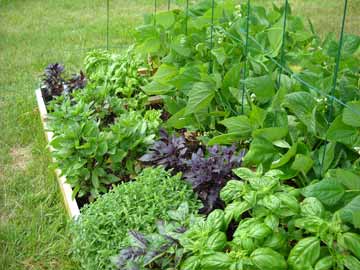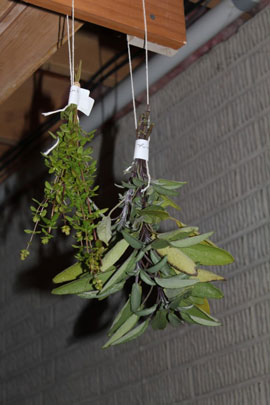Everyone would love to have fresh herbs year-round but most of us have at least a month or two of frosty, snowy weather when the perennial herbs are dormant, and the annual herbs have been killed by the first frost. Some herbs, such as parsley can be harvested mid-winter by digging under the snow to find it, and some herbs can be grown on a sunny windowsill, but the best way to get great flavor from herbs in winter is to preserve them when they are at their peak in summer through fall.
 Harvest herbs at their peak
Harvest herbs at their peak
© Kate Copsey
By late summer the herbs are still growing strongly and preserving them can be done in a variety of ways – freezing, drying or preserving in a third medium such as vinegar.
Pick the fresh herbs early in the day when they are dry from dew, and rinse under a cool running water to remove any grit or insects. Dry on paper towel, then strip the leaves (French tarragon, oregano, mint) and use one of the following methods to preserve.
Chives freeze very well and it is best to use the ‘open freeze’ method. Chop the chives into ½” pieces and scattered onto a cookie pan. Put the pan in the freezer until the chives are frozen, then store in a freezer bag. Take out handfuls for soups, casseroles or to garnish baked potatoes.
Parsley also freezes well – which is why you can dig under the snow to find it. Finely chop flat leaf parsley or divide curly leaf parsley into florets, and open freeze. Pack into bags for use in stuffing for celebration turkey dinners or winter recipes.
Oregano, marjoram, mint and winter/summer savory can all be frozen. Strip the leaves and chop so that they are ready to use, then open freeze. Use on pizza, and other recipes. They can also be dried.
 Dry herbs in small bunches
Dry herbs in small bunches
© Kate Copsey
To dry herbs, tie them in small bunches and hang in a cool dry, dark place to dry. Label when they are still fresh as dried they can all look alike! If you want a combination of dried herbs, such as a general pizza mix, or bouquet garnish, dry the herbs separately before mixing together because some herbs take longer than others to dry.
Basil is perhaps the most difficult to preserve as it goes black and tasteless when frozen and turns to dust when dried. One of the better ways is in a third medium. As tomatoes are ripe at the same time as the basil, try making a tomato sauce with lots of basil included, then freeze in small containers. The basil flavor is taken up the sauce giving the right taste when you need it.
Mint can also be preserved in vinegar for traditional mint sauce. Chop the mint and place in a small container, then cover with red wine vinegar and process for 5 minutes in a water bath. Once opened, refrigerate the container.
To maintain a good supply of herbs through the summer for kitchen use and preserving, they benefit from fertilizer a couple of times a year. Sprinkle a granular all-purpose plant food on the ground in spring, as the perennial herbs are breaking dormancy, then again in summer when you start harvesting them. Always follow the packet for how much to put down, and use a trowel or fork to work the granules into the soil.
By Kate Copsey, Garden Writer and Author